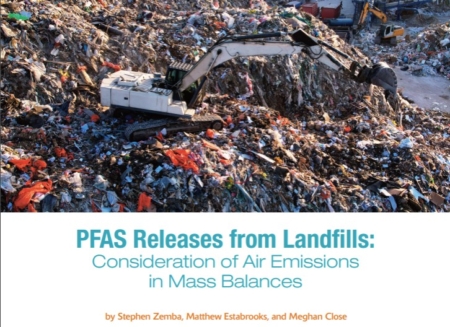This last PFAS blog of 2023 focuses on air, and it raises more questions than it provides answers.
Much of the regulatory attention on PFAS has focused on drinking water, which is viewed as the primary exposure route for most people. Soil is arguably an important reservoir for PFAS, primarily because of its potential to serve as a source of drinking water contamination. Air transport and exposure pathways have received comparatively little attention, but could that change? Breathing PFAS in air is not likely a large source of exposure for most people. ITRC’s literature review indicates airborne PFAS levels range mostly between 0.1 and 10 pg/m3, which translates to 0.002 to 0.2 ng/day of exposure for the average adult inhalation volume of 20 m3/day. These exposures are much smaller than the 8 to 140 ng/day received by drinking 2 L/day of water containing PFAS at 4 ng/L and 70 ng/L, respectively. Consequently, air is likely to be an important source of PFAS exposure only in cases where PFAS is largely absent from drinking water – or possibly in the vicinity of significant emission sources.
However, air may be an important transport medium. Deposition of airborne emissions of PFAS has been interpreted to be responsible for contamination of drinking water wells in the vicinity of industrial sources that manufactured PFAS, Teflon, and AFFF, or used them as a processing aid or a mist suppressant. Similarly, background levels of PFAS detected in soils throughout Vermont, Maine and other states may have resulted from the deposition of PFAS emissions transported from distant sources. The timing of the deposition that has led to the presence of PFAS in soils is an interesting question. If largely historical, how much should we focus on present day PFAS emissions, and what are important emission sources? More source testing is likely as implementation of stack test methods such as OTM-45 become more widespread. How effective is combustion at destroying PFAS? Initial fears have seeded the notion that PFAS are difficult to destroy, but a recent test at a hazardous waste incinerator found >99.9999% destruction of target PFAS, though products of incomplete combustion such as CF4 were not examined. What levels of PFAS are destroyed or emitted by existing municipal waste combustors, or what is the likely fate of PFAS in facilities that propose to pyrolyze biosolids? PFAS are known to be present in the input material or “fuel” of each, and there is the potential that some levels of PFAS are (or will be) emitted. If this is the case, what does the PFAS mass balance look like, and are the levels that are (or could be) emitted significant contributors to the existing environmental load of PFAS? Some sources may be difficult to assess, and changes in PFAS use add complications. For example, an ongoing study of PFAS in landfill gas has identified the presence of volatile fluorotelomer alcohols (FtOHs) that likely form from the degradation of “precursor” PFAS that replaced the perfluorinated compounds (PFCs) used for decades prior to the Stewardship Program. Once in the atmosphere, the intermediate FtOHs may be further degrading to stable PFCs that deposit to soils and disperse PFAS to the general environment. As the focus on PFAS emission sources grows, the importance of sources as they contribute to PFAS exposure and environmental loadings need to be considered in setting regulatory priorities.
Posted In: Articles
Tagged In: Development, PFAS, Research






